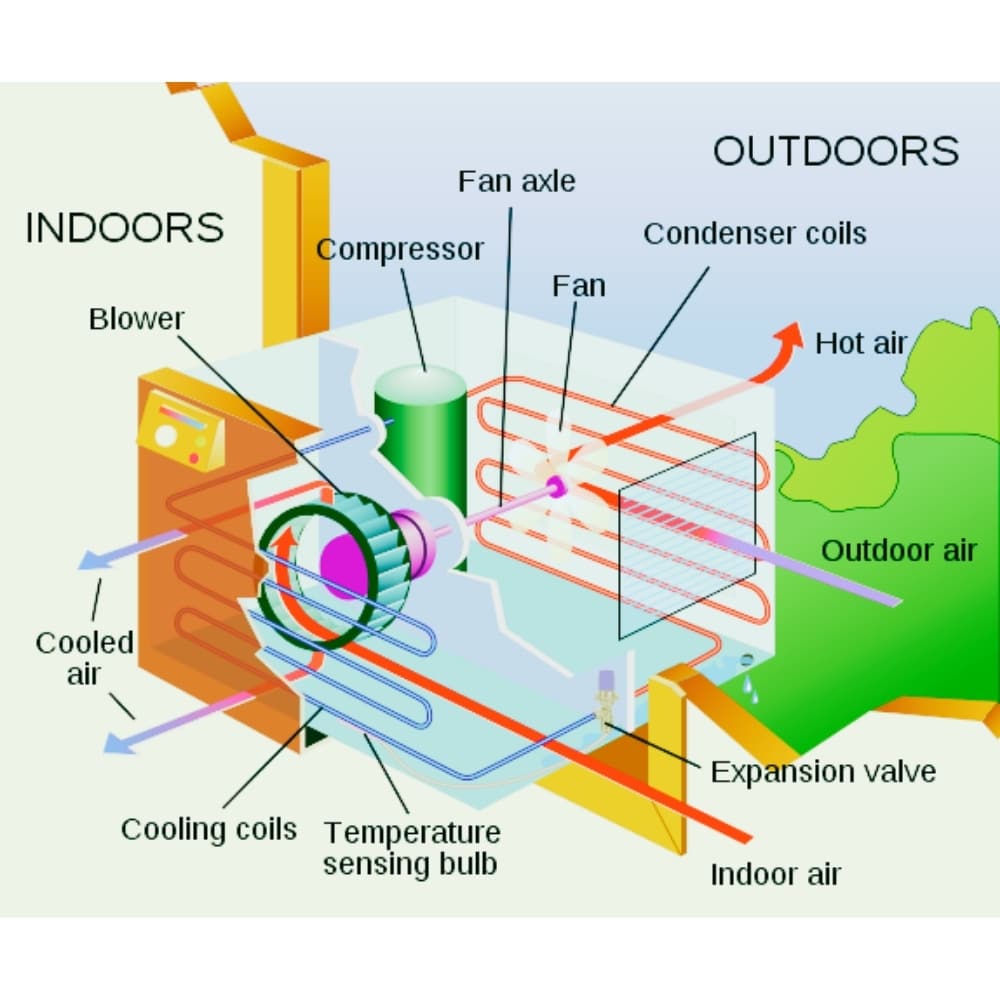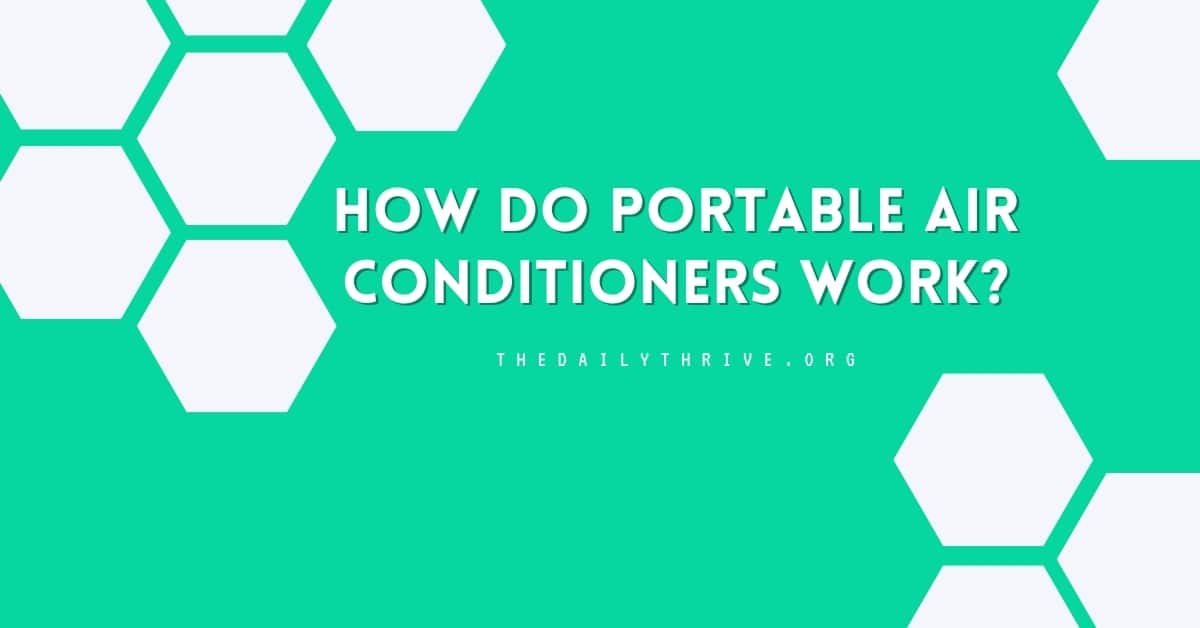A portable Air Conditioner is a compact, mobile appliance that lets you take control of the indoor temperature, so you can be cool and comfortable even in the hottest weather. Like window and wall units, portable air conditioners provide cooling in rooms and buildings where central air conditioning is not available. If you live in an apartment, studio, or older home where you can’t install central AC, these self-contained cooling units will give you welcome relief during the summer.
But unlike window or wall units, portable ACs do not require permanent installation – there is no need to break through a wall or reconfigure a window in order to use it.
Instead, a flexible exhaust hose vents hot air through a window to the outside. Typically outfitted with caster wheels, they’re easy to move around and set up wherever you need to provide spot cooling.
How Does it Work?
All air conditioners work under the same principle of cooling, which is very similar to what keeps your refrigerator cold. The key component is chemicals that convert easily between gas and liquid states. These refrigerants, such as Freon, allow the transfer of heat from inside the building to the outside.

There are three major components of an air conditioner:
Compressor
Squeezes the refrigerant, forcing it into a hot, high-pressure gas, and pumps it into the condenser.
Condenser
A long coil that allows the heat to radiate from the refrigerant – the dissipating heat is exhausted outside. As the refrigerant cools, it turns back into a liquid and then passes through an expansion valve into the evaporator.
Evaporator
Another long coil. Inside, the pressure drops, and the refrigerant begins to turn into a gas. This process of evaporation pulls heat from the air to use as energy to power the transformation from liquid to gas. The cold air that is produced by the process of evaporation is blown into the room by a fan.
When the refrigerant leaves the evaporator coil and returns to the condenser, it is once again a cool, low-pressure gas, and the cycle begins again.
Usually, in a central air conditioning system, the compressor and condenser are housed in a separate unit outside, while the evaporator is indoors and connected to the building’s ductwork.
In a portable air conditioner, all components are housed together in a single unit. An exhaust hose collects the hot air produced by the condenser and filters it outside through a window. It’s crucial when setting up a portable AC that the exhaust hose is connected properly, or all the hot air will blow directly back into the room you’re trying to cool.
What’s a BTU, and Why Do I Care?
How well do portable air conditioners really work? The simple answer to this common question depends primarily on the cooling power of the individual unit.
The BTU rating of an air conditioner refers to how much heat it can remove from the area in one hour. The higher the number of BTUs, the larger the room the unit can effectively cool.
Central ACs for suburban homes might rate as high as 72,000 BTUs. Mobile ACs generally range between about 7,000 BTUs, which can cool about 150 square feet, to 16,000 BTUs, for areas as large as 525 square feet.
It’s important to make sure you buy the right-sized unit for the area you want to cool. Buying one that is too small or too large will leave you feeling dissatisfied with its cooling performance. Check out our guide on portable air conditioners and BTUs for more information.
Portable Air Conditioners Features
Key features that makes portable air conditioners attractive, include:
- Improved Air Quality – many units include specialized filters, such as carbon and ion filters, that work to purify the air.
- Eco-Friendly – a compact room portable air conditioner costs about as much to run as a light bulb. It doesn’t get any more cost effective than that, meaning that you’re using less energy to run your appliance, which in turn does not waste resources as a traditional central ac would.
- Size Variety – as seen in the above paragraph, portable units come in all sizes that allows for diverse functional use, ranging from your home to a sports stadium.
- Type Variety – in addition to coming in different sizes, a little known consumer fact is that portable ACs also vary in type. There are two types of units – traditional cooling units and evaporative coolers
Dehumidification and Self-Evaporating ACs
Because cold air can’t hold as much moisture as warm air, condensation occurs as the air passes over the evaporator coils- think of it like water beading on the outside of your cold glass of lemonade. The water pulled from the air collects on the coils and must be drained away. Central, window, and wall ACs usually just let this water drip away outside.
In a portable room air conditioner, however, this water is collected in a bucket that must be periodically drained. Many newer models feature “auto-evaporative” or “self-evaporating” technology, which is able to process the excess moisture and vent most or all of it outside along with the hot air. This means that, except in extremely humid weather, you won’t have to empty the tank at all.
Dehumidification – removing water from the air – is an important part of how air conditioners make us feel cooler. High humidity makes our skin feel warmer and sticky because the moisture prevents our bodies from radiating heat. By removing the moisture from the air, our bodies are able to cool themselves more effectively, so we feel more comfortable.
Heat Pumps
More and more portable air conditioners include heat pumps that allow the unit to function as a space heater, providing warm air in cold weather.
In the simplest terms, all a heat pump does is switch the air conditioning cycle in reverse by reversing the flow of liquid through the coils. Instead of blowing hot air outside, it blows the heated air inside.
A heat pump air conditioner is a very energy-efficient way of providing spot heating during cold weather and allows you to use your mobile AC as a year-round appliance.
Single And Dual Hose Units
When comparing mobile air conditioners, you will discover you have a choice between single-hose and double-hose units.
- Single-hose air conditioners
Pull air from the room, cool it, and blow that air back into the room. During the cooling process, a small amount of the air in the room is removed from the room through the exhaust hose, creating “negative pressure” in the room. Air must continuously seep into the room from adjacent spaces to replace what’s been lost, which reduces the efficiency of the unit slightly.
- Dual-hose air conditioning units
Use one hose to pull in air from the outside and a second hose to exhaust hot air and moisture outdoors. Because they are constantly pulling in warmer outside air and cooling it, there is a loss of efficiency compared to single-hose units, which are cooling already-conditioned air.
There is no “better” choice between the two configurations – it’s largely a matter of personal preference and budget.
Portable Air Conditioners Installation
Although portable room air conditioners don’t require permanent installation, there is some minor work that must be performed each time it is moved from one room to the next. Set up is simple and usually doesn’t take more than five minutes with the venting kit that’s included with most units.
The venting kit consists primarily of a flat insert that fits into your window and can easily be moved wherever you need it. To see how easy it is to properly vent your free-standing AC, click here.
Final Though
Ideal for spot cooling, portable air conditioners provide economical cooling that is ideal for all environments, including homes, hospitals, offices, and server rooms.
Server rooms are a special example of the dualities of portable ac units. While most offices have a central AC unit, server room air conditioning is a big concern for businesses with server equipment. Server equipment generates a considerable amount of heat that could damage the tech systems unless a cool room temperature is maintained. The general office temperature is not adequate for a server room; however, lowering the central AC temperature is not only expensive but will yield complaints from soon-to-be sick employees. Proper server room air conditioning can be achieved if a portable AC unit is used, which will not only be affordable but efficient.
Another case of how well portable AC units work is during events. Events and large functions are other areas where portable air conditioners can be an excellent way to keep guests cool. Perhaps you have a summer wedding coming up or a large-scale event in some stuffy un-ventilate room in the middle of July? Here is where a portable AC unit will make all the difference and keep your guests talking about the party rather than the heat.
A portable AC is a convenient, easy-to-use way to keep you and your family cool through the summer. If you have questions about how portable air conditioners work, don’t hesitate to call our cooling experts – we’ll be happy to help you.






